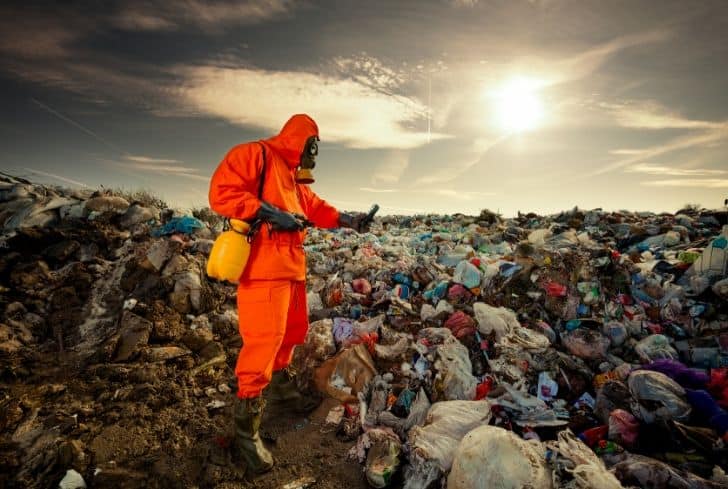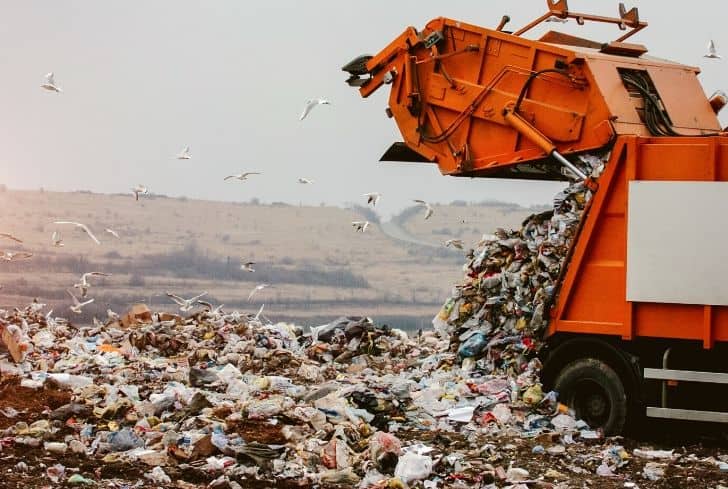Landfills are neither open dumps nor just some big hole in the ground. A basic landfill involves the covering of solid waste with soil.
A landfill is important in that it reduces the amount of dangerous landfill gases, for instance, methane and carbon dioxide, from sneaking into the air and causing harm to the planet and its inhabitants.
Large, sophisticated landfills are specially designed sites trenched into the Earth. They have a unique design that prevents leachates from reaching and potentially contaminating the water table.
Modern landfills even have sensors to detect landfill gas emissions and leachate content. In this article, let’s look at the various advantages and disadvantages of landfills.
What Are the Main Causes of Landfills?
Exploring landfill concerns, the initial factors contributing to this issue originate from various sources in our daily lives. Some of the common causes include:
1. Population Growth and Urbanization
Increasing urbanization and population rates are among the top reasons landfills keep increasing. The more the population, the more the demand for goods and the more the waste is generated and dumped.
2. Agricultural Waste
Arises mainly from farm remains, animal manure, and worn-out agricultural produce. All these are dumped owing to their highly toxic nature and may contaminate land and water.
3. Solid Waste
This is the major contributor to landfills. Solid waste includes trash from markets, hotels, houses, public spaces, schools, and malls. Damaged wooden materials, plastics, electronic waste, and medical waste are also considered solid waste. Most of these materials are non-degradable and hazardous, leaving landfills as their only way of disposal.
4. Industrial and Construction Waste
They include waste from power plants, manufacturing units, oil refineries, etc. Most of them are biodegradable and add up to fill the landfills.
What Happens to the Waste in a Landfill?

Trash put in a landfill stays there for a very long time. Oxygen and moisture content inside a landfill is very little. Under these conditions, trash breaks down slowly.
In fact, landfills are not designed to break down the waste materials, merely to bury them. Once space fills up, landfills are usually capped. General trash and hazardous waste materials take different capping systems:
For hazardous waste:
- Synthetic material is used to cover the waste. This is then topped with two feet of compacted clay.
- A drainage layer is employed to get rid of liquids and chemicals as the waste breaks down
- And finally, a layer of dirt or topsoil completed the capping system
For general waste:
- A solid liner system sits at the bottom of the landfill
- Alternate layers of compacted clay and synthetic material are used to cover the landfill site
- And a final layer of topsoil is added over the clay.
Advantages of Landfills
While landfills are associated with certain negative perceptions, it’s important to recognize their potential advantages to waste management and environmental conservation.
1. Landfills Are an Excellent Energy Source
Carbon dioxide and methane are produced when trash accumulates and begins to break down. These gases can be taken out, filtered, and used to produce energy.
In the United States, landfills serve as the third source of methane production. The landfills in the country also produce approximately 95.6 million of these Carbon (IV)oxide per annum.
2. Modern Landfills are Eco-friendly
Initially, landfills were just open-air dumps for nearly everything. But that isn’t the case anymore, thanks to the efforts of environmental experts and conservationists who brought in strict laws, regulations, and standards for landfill sites.
Nowadays, technology is well utilized in the landfills’ design; good soil lining and leachate management systems ensure no seepage and damage.
3. Keep Cities, Towns, and Districts Clean
In any city that doesn’t have a landfill or when people know there is no efficient waste management system in place, they would dump waste in the vacant spots.
This is unhealthy for humans and the environment. With properly maintained landfill facilities, local trash will be dealt with locally instead of shifting to other countries.
4. Keeps Hazardous Waste Segregated
Landfills provide a place to dump recyclable and non-recyclable waste separately. Also, they provide a place to keep more hazardous materials that need to be segregated from the public.
5. Landfills are Cheap
Garbage transport costs will be reduced, as our waste will only have to travel a short distance to landfill. This will also reduce the amount of pollution caused by transporting rubbish.
6. Landfills Support Jobs and Local Business
An effective waste management system of any country is a million-dollar activity, with every stage of the process needing a workforce. More local landfills mean more job opportunities and better living for the locals.
Disadvantage of Landfills
Burying waste in the ground is advantageous in many ways. But what are the disadvantages of landfills?
Let’s take a look.
1. Landfills are Partially Responsible For Climate Change
One tonne of biodegradable waste can produce about 400–500 cubic meters of landfill gas. Landfill gas contains methane and carbon dioxide as the major constituents and traces of other gases.
Methane is a greenhouse gas that is 25x more potent than carbon dioxide in trapping heat in the atmosphere. Thus, it increases the implications of global warming and climate change.
2. Methane Lights up Easily
Methane is a highly flammable gas. In an enclosed space with poor ventilation, this gas lights up easily and can set the entire landfill site ablaze in seconds. Fire can start if the methane concentration is 5 to 15% of the total air volume.
But all danger doesn’t solely lie in methane. Dioxin emissions from the fires are also hazardous to the environment, not to mention the damaging effects they have on the underground water layer.
3. Landfills Contaminate Soil and Water
Although it’s not very common for the protective membranes of landfills to rupture, it can be devastating when they do. Hazardous chemicals, gases, and toxins seep from landfills and get mixed with soil and groundwater, causing soil and water pollution.
The infiltrated metals, ammonium, carbons, and other toxins make the soil lose its texture and naturality and kill aquatic flora and fauna.
4. Landfills Affect Wildlife
Landfill sites have negative effects on plants and animals. Certain birds and animals feed on landfill sites. By doing so, they ingest plastic, aluminum, drywall, and other materials.
A study shows white storks modified/shortened their regular migration and chose nests in areas close to landfill areas. This is detrimental and can be fatal for the birds in the long run.
5. Accidents Can Happen
Rain, spontaneous combustion of gases or materials, or excessive waste accumulation makes landfill sites vulnerable to collapses. When that happens, the damages are deep and almost irreversible.
About a month later, the Meethotamulla landfill site in Sri Lanka suffered the same fate, destroying 140 houses and taking 30 lives. In February 2020, two workers died when the Zaldívar landfill site in Spain collapsed.
6. Landfills Affect Human Health
Studies have shown that people living near or prolonged exposure to landfills have been linked to cancer, respiratory disorders, and developmental defects in children.
Short-term exposure to ammonia and hydrogen sulfide in the air can cause eye, nose, and throat irritation and asthma. Other reported health complaints include sleeping difficulties, weight loss, and chest pain.
Methane and carbon dioxide can affect oxygen availability to tissues, causing coordination issues, fatigue, nausea, vomiting, and unconsciousness.
How Old Landfills Are Used For Today?
Old landfills aren’t dead spaces anymore. They are getting a serious makeover in public parks and wildlife habitats.
1. Community Parks

One of the most popular ways to transform old landfills is to convert them into a public park. Landfill parks go back to 1916 when the old Rainier Dump in Seattle was turned into the Rainier Playfield, a public sports facility.
More than a thousand parks are sitting on old trash sites worldwide. From green spaces to golf courses to skate parks – the possibilities are endless. Some famous names include Washington Park Arboretum, Pulau Semakau Eco-Park, Singapore; Chambers Gully Reserve, Australia; and Red Rock Canyon Open Space, Colorado.
2. Landfill Energy Projects
Capped landfills are also repurposed into energy production sites. Generating energy from landfill gas isn’t new, and the electricity produced is used to power everything from homes to vehicles.
Many countries have their solar panel fields installed in old landfills. One such example is the one installed by Public Service Electric and Gas Co, New Jersey.
3. Wildlife Habitats

Environmental conservationists are voicing out for old landfills to be transformed as wildlife habitats. They suggest testing soil profile and water table of the locality to confirm if they can support vegetation and wildlife.
One example is the Alliance Landfill in Taylor, Pennsylvania. Native trees and other plant varieties were introduced and over time, many bird and animal species made it their home.
Bottom Line
Waste around us needs more attention than ever before. Today’s landfills have progressed from simple pits to meticulously engineered waste management systems. They intend to reduce pollution, control contamination, and protect our health and environment. While we can never rule out contamination risks, landfills are essential to keep the cities as clean and healthy as possible.
References:
https://www.health.ny.gov/environmental/outdoors/air/landfill_gas.htm







